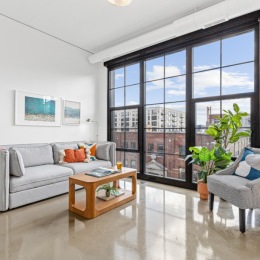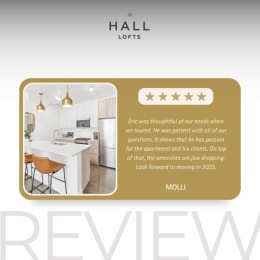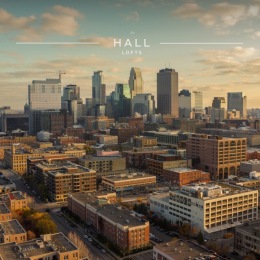Why Historic Buildings Make Perfect Modern Homes
Apartments in historic buildings offer unique living experiences that blend past and present. If you're looking to rent or buy a historic apartment, here are the key benefits:
- Architectural character not found in new construction
- Prime urban locations in vibrant neighborhoods
- Unique features like exposed brick, high ceilings, and original woodwork
- Sustainable living through adaptive reuse of existing structures
- Connection to local history and community identity
The charm of historic apartments comes from their storied past and distinctive character. As Frederick Anhalt, the influential Seattle developer whose buildings still define neighborhoods today, proved - you don't need to sacrifice modern comfort for historic charm. Many of his buildings from the 1920s and 1930s have been thoughtfully updated while preserving their unique architectural elements.
"Come home to a place where local history and elegance intertwine seamlessly," as one Portland historic property describes the experience. This perfectly captures why many urban professionals choose historic buildings over new construction.
From Seattle's Victorian Row Apartments (built in 1891) to Philadelphia's converted Chocolate Works (formerly the Wilbur Chocolate Company), these buildings tell stories through their architecture while providing thoroughly modern living spaces.
The process of changing historic structures into contemporary living spaces involves careful preservation of original elements while integrating modern conveniences like high-speed internet, in-unit laundry, and energy-efficient systems.
Many historic apartment buildings have been designated landmarks, ensuring their character will be preserved for future generations. This landmark status often comes with location benefits too - these buildings typically sit in established neighborhoods with excellent walkability, dining options, and cultural attractions.

1. Built-In Character & Craftsmanship
There's something magical that happens when you first step into an apartment in a historic building. It's that unmistakable feeling—a sense that these walls have stories to tell. This isn't just about pretty old buildings; it's about craftsmanship that has largely disappeared from modern construction.
"You can feel the history of eccentrics, elites, and artists from the first golden era surrounding you," as one historic Omaha apartment building puts it. And they're right—it's not marketing fluff but the genuine sensation of entering a space with a rich past.
What makes these spaces so special? It might be the hand-laid brick walls with their perfect imperfections, or original hardwood floors that have been polished by decades of footsteps. Perhaps it's the detailed crown molding that frames your ceiling, or that charming fireplace that serves as the room's natural focal point. In many historic apartments, you'll find transom windows letting in light from unexpected angles, or grand staircases with banisters carved by artisans long ago.
Here at The Hall Lofts, we've taken great care to preserve these architectural treasures throughout our Minneapolis warehouse conversion. The goal has always been to honor the building's history while seamlessly blending in modern comforts.
Why "apartments in historic buildings" feel one-of-a-kind
If you've ever toured multiple units in a newer building, you've probably experienced déjà vu—the same layout, the same finishes, just on different floors. Historic buildings couldn't be more different.
Consider Seattle's Highland Apartments, built in 1924 and lovingly restored in 2021. Originally designed for wealthy residents, each apartment offered unique features like formal dining rooms, cozy sunrooms, and even quarters for household staff. These weren't cookie-cutter units—they were individual homes with personality.
Or look at Philadelphia's Chocolate Works, where industrial elements from its days as a candy factory become stunning design features in modern living spaces. Massive timber beams, factory columns, and oversized windows don't hide the building's past—they celebrate it.
The charm often comes from unexpected architectural surprises. You might find a turret room with gently curved walls in a Victorian-era building, or an original butler's pantry that makes a perfect home office nook. Arched doorways frame your passage from room to room, while built-in shelving offers both practicality and period charm.
These details aren't just decorative—they're connections to the past. That slightly uneven spot on your hardwood floor? It might mark where factory machinery once stood. The exposed brick wall in your living room links you directly to the craftspeople who laid each brick by hand generations ago.
At The Hall Lofts, we believe these elements create a sense of place and belonging that simply can't be manufactured in new construction. When you live in a historic building, you're not just a resident—you're a steward of something special, a chapter in an ongoing story that began long before you arrived and will continue long after.
2. Prime Locations Rooted in History
There's a reason why apartments in historic buildings come with enviable addresses—they were built when location truly was everything. Before cars dominated city planning and suburban sprawl became the norm, these architectural gems were strategically placed along streetcar routes, near thriving business districts, and within walkable neighborhoods.
This historical pattern has created an unexpected modern benefit: residents of these buildings now enjoy some of the most coveted real estate in their cities. The Victorian Row Apartments in Seattle offer a perfect example. Built in 1891 on what was once considered the city's edge, this historic treasure now sits in a prime location that has only grown more desirable as Seattle expanded around it.
When you choose a historic apartment, you're not just selecting a beautiful space—you're investing in:
- Prime positioning in established, character-rich neighborhoods
- Easy walking distance to local cafés, boutiques and cultural venues
- Convenient access to public transit options
- Neighborhoods with mature trees and established parks
- Communities designed for people, not cars
In Philadelphia, residents of the Chocolate Works apartments (once the busy Wilbur Chocolate Company) now stroll cobblestone streets to reach nearby galleries, restaurants, and shops—all thanks to their Old City location that has evolved over centuries rather than being master-planned overnight.
How historic zoning shaped today's hottest neighborhoods
The most sought-after urban neighborhoods often share a common origin story: they were shaped by early zoning patterns that historic buildings exemplify. Minneapolis' North Loop change tells this story beautifully. What local residents describe as "a dirty, rundown, almost-forgotten section of downtown Minneapolis 25 years ago" has blossomed into "a vibrant entertainment, residential and business district"—with historic warehouses like The Hall Lofts leading the way.

This pattern repeats across America's most vibrant urban centers. Seattle's Belltown evolved from industrial roots to become a walkable hub of city life. Portland's Pearl District transformed warehouse spaces into galleries and lofts. Minneapolis' North Loop converted industrial buildings into stylish residences and retail spaces. Philadelphia's Old City reinvented manufacturing facilities as luxury homes.
What makes these neighborhoods special isn't just their buildings—it's the mixed-use zoning that predates modern single-purpose planning. Before suburban-style zoning separated where we live from where we work and play, neighborhoods naturally blended these functions. The result? Communities where everything you need sits within easy reach.
Residents of historic apartments in Portland's Pearl District enjoy an impressive Walk Score of 96 ("Walker's Paradise"), while those in Minneapolis' North Loop benefit from exceptional transit access and bike-friendly infrastructure. You can learn more about walkability scores and their impact on urban living at Walk Score's official website.
At The Hall Lofts, our North Loop location means you're perfectly positioned to enjoy Minneapolis' best urban experiences—from riverside parks to downtown attractions to neighborhood restaurants—all because we're housed in a historic warehouse district that has organically evolved into one of the city's most coveted neighborhoods.
3. Sustainability & Adaptive Reuse
Living in an apartment in a historic building isn't just stylish—it's an environmentally responsible choice that makes a real difference. As the saying goes among preservationists, "the greenest building is the one that already exists."
When you choose a historic apartment like those at The Hall Lofts, you're participating in adaptive reuse—giving new life to existing structures rather than tearing down and building new. This choice comes with substantial environmental benefits that many residents find deeply satisfying.
The carbon footprint of renovating a historic building is dramatically smaller than constructing a new one. Each brick, beam, and floorboard represents embodied energy—the resources already spent decades ago in manufacturing and installing these materials. By preserving them, we honor that investment while avoiding the environmental costs of new production.

Take Portland's Esquire building, originally the Calumet Hotel from 1907. Its thoughtful restoration earned coveted LEED Gold certification—a remarkable achievement for a century-old structure. The renovation incorporated eco-friendly heating and cooling systems alongside an artistic rainwater recovery system, proving that sustainability and historic character can beautifully coexist.
Similarly, Seattle's Victorian Row Apartments narrowly escaped the wrecking ball in 1993. Through creative use of historic tax credits, this 1891 treasure was transformed into 14 distinctive homes. What could have been construction waste filling landfills instead continues to shelter and delight residents while maintaining its irreplaceable historic character.
Modern upgrades hidden behind vintage walls
What makes historic apartments truly special is how they seamlessly blend old-world charm with modern convenience. Behind those characterful brick walls and beneath those gleaming hardwood floors, you'll find thoroughly modern systems that support comfortable, efficient living.
At The Hall Lofts, we've taken great care to integrate contemporary infrastructure throughout our historic warehouse conversion. While you'll still enjoy the authentic aesthetic of exposed brick and original timber beams, you'll also benefit from high-efficiency heating and cooling, updated electrical systems that support today's technology needs, and modern plumbing with water-saving fixtures.
This balance of preservation and modernization is evident in buildings like Seattle's Highland Apartments. Their 2021 restoration included comprehensive earthquake proofing and all-new electrical and plumbing systems while carefully preserving the 1924 building's historic character and details.
The sustainability benefits extend well beyond the building itself. Historic buildings typically occupy walkable neighborhoods with easy access to public transportation—reducing car dependency and associated emissions. Their central locations use existing infrastructure rather than extending utilities into undeveloped areas, helping combat urban sprawl.
For more information about green building practices and LEED certification for historic structures, visit the U.S. Green Building Council's website, which provides comprehensive resources on sustainable building practices.
When you walk into your apartment at The Hall Lofts, you might notice the character of well-worn brick or the patina of original woodwork. What you might not immediately see are the high-speed internet connections, energy-efficient appliances, and in-unit laundry thoughtfully integrated into the historic fabric. This blend of old and new represents the best kind of sustainability—honoring the past while embracing the future.
4. Community & Cultural Identity
Living in an apartment in a historic building isn't just about the physical space—it's about becoming part of something bigger than yourself. These architectural treasures create natural communities where neighbors connect through shared appreciation of their building's unique character and story.
Historic buildings naturally foster community in ways that newer developments often try to replicate but rarely achieve with the same authenticity. At The Hall Lofts, we've seen how our shared courtyards become natural gathering spaces where residents chat while enjoying morning coffee among century-old brick walls.
Many historic apartment buildings feature thoughtfully designed common areas that bring people together:
That sense of community extends beyond just physical spaces. There's something special about sharing a morning elevator ride with a neighbor and exchanging stories about the building's quirky elevator that's been running since 1920. Or gathering for summer rooftop events with spectacular views framed by original architectural details that have watched over the city for generations.
Ground-floor retail spaces in historic buildings often house local businesses that become neighborhood institutions. The European-style café in Seattle's Belroy doesn't just serve residents—it welcomes the entire neighborhood, creating a vibrant hub where community naturally forms.
When you visit our amenities page, you'll see how we've balanced preserving historic character with creating spaces where residents naturally come together.
"Apartments in historic buildings" anchor neighborhood pride
Historic buildings aren't just places to live—they're neighborhood landmarks that help define local identity. Their distinctive facades become orientation points, their stories become neighborhood lore, and their preservation becomes a point of community pride.
In Minneapolis' North Loop, The Hall Lofts is part of the warehouse district's change story. What began as a few pioneering conversions has grown into one of the city's most vibrant neighborhoods, with historic buildings serving as the backbone of its identity.
This connection between historic buildings and neighborhood character runs deep across American cities. When you live in a historic apartment, you're not just renting space—you're becoming part of an ongoing story that spans generations. Many residents develop a genuine sense of stewardship toward these buildings, participating in preservation efforts and community events that celebrate local heritage.
We've seen how residents at The Hall Lofts naturally become ambassadors for both the building and the neighborhood. They take pride in knowing the history behind those exposed brick walls and massive timber beams. They enjoy telling friends about how their apartment was once part of a busy warehouse where workers packed and shipped goods across the Midwest.
Many historic apartment communities incorporate local art that reflects neighborhood identity. From gallery spaces in former industrial hallways to community events in historic common areas, these buildings facilitate cultural connections in meaningful ways. When you walk through our halls, you'll notice how we've incorporated elements that tell the North Loop's story—a neighborhood that evolved from industrial powerhouse to creative urban center.
This blend of history, community, and culture creates living environments with soul and substance. When you choose an apartment in a historic building, you're not just finding a place to live—you're joining a community with roots and a shared appreciation for the stories embedded in every brick, beam, and doorway.
5. Challenges & Smart Solutions
Living in an apartment in a historic building comes with incredible rewards, but let's be honest – these architectural gems present unique challenges too. At The Hall Lofts, we believe in transparency about both the charms and challenges of warehouse living, along with the creative solutions that make historic spaces work beautifully for modern residents.
Turning potential headaches into perks
When you tour a historic apartment, you might wonder about practical matters – like where you'll park your car in a building designed before automobiles existed, or how you'll manage stairs in a pre-elevator era structure. These are valid concerns, but they've inspired some of our most innovative solutions.
Take parking, for instance. While our North Loop warehouse wasn't designed with cars in mind, we've transformed this potential limitation into a benefit through reserved covered parking options. No more circling the block or braving Minnesota winters with an ice scraper! Many residents actually prefer our structured parking solution to the surface lots common at newer buildings.
Accessibility concerns in historic buildings have led to thoughtful renovations that respect architectural integrity while ensuring everyone can enjoy these spaces. Modern elevator additions often occupy former freight elevator shafts or light wells, preserving the building's character while improving accessibility. At The Hall Lofts, we've integrated these improvements seamlessly, making our historic spaces welcoming to all.
Sound transmission between units – often cited as a concern in older buildings – has become another opportunity for innovative solutions. The thick masonry walls in many historic apartments actually provide superior sound buffering compared to modern construction. Where needed, we've added acoustic underlayment beneath those gorgeous restored hardwood floors, creating peaceful spaces without sacrificing character.
Pet-friendly policies might seem at odds with historic preservation, but we've found they go hand-in-hand with adaptive reuse. Our four-legged residents enjoy amenities like dedicated pet wash stations (cleverly incorporated into former utility spaces) and easy access to neighborhood walking routes. The warehouse durability that served industrial purposes now stands up beautifully to enthusiastic pets – those original concrete floors were built to last!
Energy efficiency presents another challenge in historic structures. Rather than viewing this as a drawback, we've acceptd it as an opportunity to incorporate state-of-the-art systems behind those character-rich walls. Modern HVAC systems, efficient windows designed to match historical styles, and strategic insulation create comfortable, energy-conscious living spaces while preserving architectural details.
The 724 Lofts in Minneapolis' North Loop exemplifies this balance of preservation and modernization. Their 2022 renovation of an 1892 building incorporated earthquake proofing and modern systems while maintaining the structure's historic integrity – proving that century-old buildings can exceed today's standards for comfort and safety.
At The Hall Lofts, we've transformed every challenge into an opportunity. Those massive timber columns and beams that once supported industrial equipment? They're now stunning architectural focal points in living spaces. Former freight elevators have become modern passenger elevators. Industrial windows flood apartments with natural light and connect residents to the vibrant North Loop neighborhood.
The result is living spaces that offer the best of both worlds – the irreplaceable character of historic architecture with the comfort and convenience today's urban dwellers expect. Rather than seeing challenges as obstacles, we view them as opportunities to create truly unique homes with stories to tell.
More info about Converted Warehouse Apartments
6. How to Find Your Own Slice of History
Finding your perfect apartment in a historic building is a bit like treasure hunting—you need to know where to look and what to look for. Unlike standard apartment searches, these architectural gems often require a more specialized approach.
Quick search tips for "apartments in historic buildings"
The hunt for historic living spaces starts with knowing the right resources. Local preservation organizations are goldmines of information about landmark buildings that have been transformed into residential spaces. The National Trust for Historic Preservation, state historic offices, and neighborhood historical societies can point you toward buildings with authentic character and stories to tell.
When you're browsing online, specific search terms will yield much better results than generic apartment queries. Try searching for "loft apartments in historic buildings," "converted warehouse apartments," or "adaptive reuse apartments" to uncover options that might not appear in standard listings. Adding your desired neighborhood to these terms (like "North Loop warehouse apartments") can further refine your results.
Buildings renovated with historic tax credits often represent the gold standard in preservation. These projects must adhere to specific guidelines that maintain historical integrity while upgrading interiors for modern living. The Federal Historic Preservation Tax Incentives program has helped transform countless historic properties into beautiful living spaces, including many in Minneapolis' vibrant North Loop neighborhood.
Historic districts naturally offer the highest concentration of preserved buildings. In Minneapolis, the North Loop neighborhood—where The Hall Lofts is located—features numerous warehouse conversions thanks to thoughtful preservation efforts. These areas often have their own distinct character, from the industrial feel of former manufacturing districts to the ornate details of Victorian-era residential neighborhoods.
Different architectural eras offer unique living experiences. Pre-1900 buildings typically showcase Victorian and Queen Anne styles with ornate woodwork and distinctive floor plans. Early 20th-century buildings might feature Beaux-Arts elements or Art Deco flourishes. Industrial conversions, like The Hall Lofts, highlight raw materials—exposed brick, timber beams, and generous windows—that tell the story of the building's working past.
The style of building you choose shapes your daily experience. A converted warehouse offers soaring ceilings and open floor plans, while a 1920s apartment building might feature arched doorways and built-in bookcases. At The Hall Lofts, we've preserved the industrial character of our Minneapolis warehouse while integrating modern comforts, creating spaces that honor the building's history while meeting contemporary needs.
Social media can also be a surprisingly effective tool in your search. Following hashtags like #historicapartments or #adaptivereuse might lead you to properties you wouldn't otherwise find. And don't underestimate the value of simply walking through historic neighborhoods—many smaller historic apartment buildings advertise vacancies with traditional signage rather than extensive online listings.
For more information about landmark buildings and their preservation, visit the National Register of Historic Places website, which provides comprehensive resources on historically significant properties across the United States.
Finding your perfect apartment in a historic building might take a bit more time than a standard apartment search, but the unique character and sense of place you'll gain is well worth the effort.
More info about Lofts in Minneapolis
Frequently Asked Questions about Apartments in Historic Buildings
Do historic apartments cost more to rent?
When it comes to apartments in historic buildings, the pricing question isn't straightforward. The charm of exposed brick and original hardwood doesn't automatically mean a higher rent check, though it certainly might.
Historic apartments often sit in prime, established neighborhoods where location alone carries value. The North Loop in Minneapolis, where The Hall Lofts makes its home, offers walkability to restaurants, shopping, and entertainment that suburban locations simply can't match. This prime positioning sometimes commands premium pricing, but not always.
What really determines the cost? It's a blend of factors. The extent of restoration work matters enormously – bringing century-old buildings up to modern standards requires significant investment. Buildings with prestigious landmark status or particularly unique architectural elements might charge more for that one-of-a-kind experience. And of course, spacious units with original features like turret windows or decorative fireplaces often come at a premium.
But here's the good news – many historic buildings offer exceptional value when you consider what you're getting. Those thick brick walls that have stood for a century often provide natural insulation that can keep utility bills surprisingly reasonable. And the character you gain simply can't be replicated in new construction, no matter the price point.
Are pets allowed in most landmark buildings?
The days of "no pets allowed" signs in historic buildings are largely behind us. Today's historic apartment communities have acceptd our four-legged family members with enthusiasm, recognizing that modern residents expect pet-friendly policies.
Many historic buildings have gotten creative with pet amenities. You'll find rooftop dog runs where warehouse workers once loaded freight, and pet washing stations tucked into spaces that might have once housed industrial equipment. Some buildings host "yappy hours" in their courtyards, building community among pet owners.
The thoughtful renovation of historic properties often includes considerations for pet-friendly living from the start. Durable flooring choices that complement historic character while standing up to paws, convenient outdoor relief areas, and partnerships with local pet service providers all make historic living with pets not just possible, but pleasant.
At The Hall Lofts, we believe pets are part of what makes a space feel like home. Our pet-friendly policies acknowledge that even in buildings with a century of history, there's always room for the joy that pets bring to our daily lives.
What modern amenities can I expect inside a century-old structure?
Behind those character-rich brick walls and beneath those gorgeous old hardwood floors, today's apartments in historic buildings conceal thoroughly modern systems. The industrial elevator shaft might now house a sleek, modern elevator. The former boiler room might be a state-of-the-art fitness center.
Inside the units themselves, you'll typically find all the conveniences of contemporary living:
The kitchens in these historic gems often surprise first-time visitors with their modern appointments – energy-efficient stainless appliances, quartz countertops, and designer fixtures blend seamlessly with historic elements like exposed brick or original timber beams. Bathrooms feature rainfall showerheads and modern vanities, sometimes juxtaposed beautifully against restored tile work or repurposed architectural elements.
Technology integration has become standard, with high-speed internet, smart thermostats, and modern security features working invisibly behind those historic facades. In-unit laundry – once unimaginable in buildings from the early 20th century – has become expected, with stacked units often cleverly tucked into former closets or utility spaces.
Community spaces in historic buildings offer their own blend of past and present. Former loading docks become package reception areas. One-time manufacturing floors transform into co-working spaces with fast WiFi. Industrial rooftops now host grilling stations and outdoor lounges with views of the city.
At The Hall Lofts, we've acceptd this balance of old and new. Our residents enjoy all the modern conveniences they need within a setting rich with authentic character and history. It's not about choosing between historic charm and modern comfort – it's about experiencing both simultaneously in a thoughtfully restored space.
Conclusion
Living in an apartment in a historic building is more than just having a place to call home—it's embracing a lifestyle that weaves together stories of the past with contemporary comforts of today. These unique living spaces offer something that brand-new buildings simply cannot: authentic character that's been decades or even centuries in the making.
From the moment you walk through the doors of a historic apartment building, you're stepping into a space where generations have lived, worked, and created memories. Whether it's the Victorian Row Apartments in Seattle with their 130+ years of history or Philadelphia's Chocolate Works where the sweet scent of confections once filled the air, these buildings have stories embedded in their very walls.
The benefits of choosing a historic home extend far beyond aesthetics:
The craftsmanship of hand-carved details and architectural elements that would be prohibitively expensive to recreate today becomes your daily backdrop. Those weathered hardwood floors, exposed brick walls, and ornate crown molding aren't just design choices—they're tangible connections to craftspeople of another era.
You'll likely find yourself in a prime location that was established long before suburban sprawl, with walkable access to the heart of the city, cultural landmarks, and local businesses that give your neighborhood its distinctive character.
By choosing a building that's already standing, you're making an environmentally conscious decision. The greenest building is one that already exists, and adaptive reuse significantly reduces the carbon footprint associated with new construction.
Perhaps most importantly, you become part of a community with deep roots and shared heritage. Historic buildings often foster connections between residents in a way that anonymous new structures struggle to achieve.
At The Hall Lofts, we've acceptd this philosophy in Minneapolis' vibrant North Loop. Our warehouse-to-loft change preserves the industrial soul of our building while creating thoroughly modern homes. The exposed timber beams and brick walls tell the story of our building's past, while updated systems and thoughtful amenities ensure comfort for today's urban dwellers.
When you're searching for your next home, look beyond the glass towers and cookie-cutter apartments. Consider the character, history, and soul of a renovated landmark. An apartment in a historic building offers more than just shelter—it provides a unique backdrop for your life story, one that connects you to both the past and future of your community.
After all, these spaces aren't just apartments—they're chapters in an ongoing story of urban evolution, preservation, and revitalization. At The Hall Lofts, we're proud to help write the next chapter of Minneapolis' architectural heritage while creating homes that blend historic character with modern living.











